If you want the best cooling for a spacious room, a 60 inch ceiling fan is usually the top pick. When you match your ceiling fan size to your room dimensions, you boost both comfort and energy efficiency. Studies show that a larger fan, like the Rackora 60 Inch Modern ABS Ceiling Fan, can move more air with less noise and energy use. Think about your cooling needs and the size of your room as you look for the perfect fan.
Key Takeaways
- Choose a 60 inch ceiling fan for large rooms or open spaces to get maximum airflow and better cooling.
- Use a 52 inch ceiling fan for medium or smaller rooms to save energy and avoid overpowering the space.
- Match your fan’s airflow (CFM) rating to your room size for the best comfort and efficiency.
- Look for fans with DC motors to enjoy quieter operation and save up to 65% on energy costs.
- Consider features like smart remote control and reversible blade direction for year-round comfort.
- Measure your ceiling height and use the right mounting option to ensure safe and effective fan installation.
- Pick blade materials like ABS for durability and water resistance, especially if you want outdoor use.
- Plan your budget to include installation costs and long-term energy savings for the best value.
Quick Comparison
Key Differences
When you start shopping for a ceiling fan for a big room, you might wonder if you should go with a 60 inch ceiling fan or a 52 inch ceiling fan. The main differences come down to size, airflow, energy efficiency, and the types of rooms each fan fits best. Here’s a quick look at how the Rackora 60 Inch Modern ABS Ceiling Fan stacks up against a typical 52 inch model:
|
Feature |
Rackora 60 Inch Modern ABS Ceiling Fan |
Typical 52 Inch Ceiling Fan |
|---|---|---|
|
Blade Span |
60 inches |
52 inches |
|
Airflow Capacity (CFM) |
~7000 (maximum airflow for large spaces) |
~5070-5580 (good for medium rooms) |
|
Room Size |
12’x12’ to 20’x20’ and larger |
Small to medium rooms (bedrooms, offices) |
|
Energy Efficiency |
High (DC motor, energy-saving features) |
Good (often DC motor, smaller coverage) |
|
Material |
Durable ABS, water-resistant |
Metal, wood, or plastic |
|
Design & Features |
Modern, luxury, smart remote, reversible |
Basic, budget-friendly, standard controls |
|
Intended Use |
Large living rooms, open spaces, commercial |
Bedrooms, small living rooms, offices |
You can see that the 60 inch ceiling fan covers more area and delivers the best airflow for big spaces. The 52 inch ceiling fan works well in smaller rooms and uses less energy for those spaces.
Tip: If you want maximum airflow and modern features for a large room, the Rackora 60 Inch Modern ABS Ceiling Fan is a strong choice. For a smaller room, a 52 inch ceiling fan can offer great efficiency and comfort.
Pros and Cons
Let’s break down the main advantages and disadvantages of each fan size so you can make the right choice for your space:
Rackora 60 Inch Modern ABS Ceiling Fan
-
Pros:
- Delivers maximum airflow, perfect for large rooms or open concept spaces.
- High energy efficiency thanks to a DC motor and smart controls.
- Modern design with durable ABS blades and water resistance.
- Smart remote with six speeds and reversible function for year-round comfort.
- Fits rooms from 12’x12’ up to 20’x20’ or even larger.
-
Cons:
- May be too large for small or medium rooms.
Typical 52 Inch Ceiling Fan
-
Pros:
- Good airflow for bedrooms, offices, and small living rooms.
- Strong energy efficiency for smaller spaces.
- Usually more budget-friendly.
- Fits most standard-sized rooms.
-
Cons:
- Not enough airflow for very large rooms or open spaces.
- Fewer advanced features compared to larger, modern fans.
When you compare both options, you’ll notice that the 60 inch ceiling fan gives you the best airflow and energy efficiency for big rooms. The 52 inch ceiling fan is a solid pick for smaller spaces where you want comfort and efficiency without extra features.
Airflow and Performance
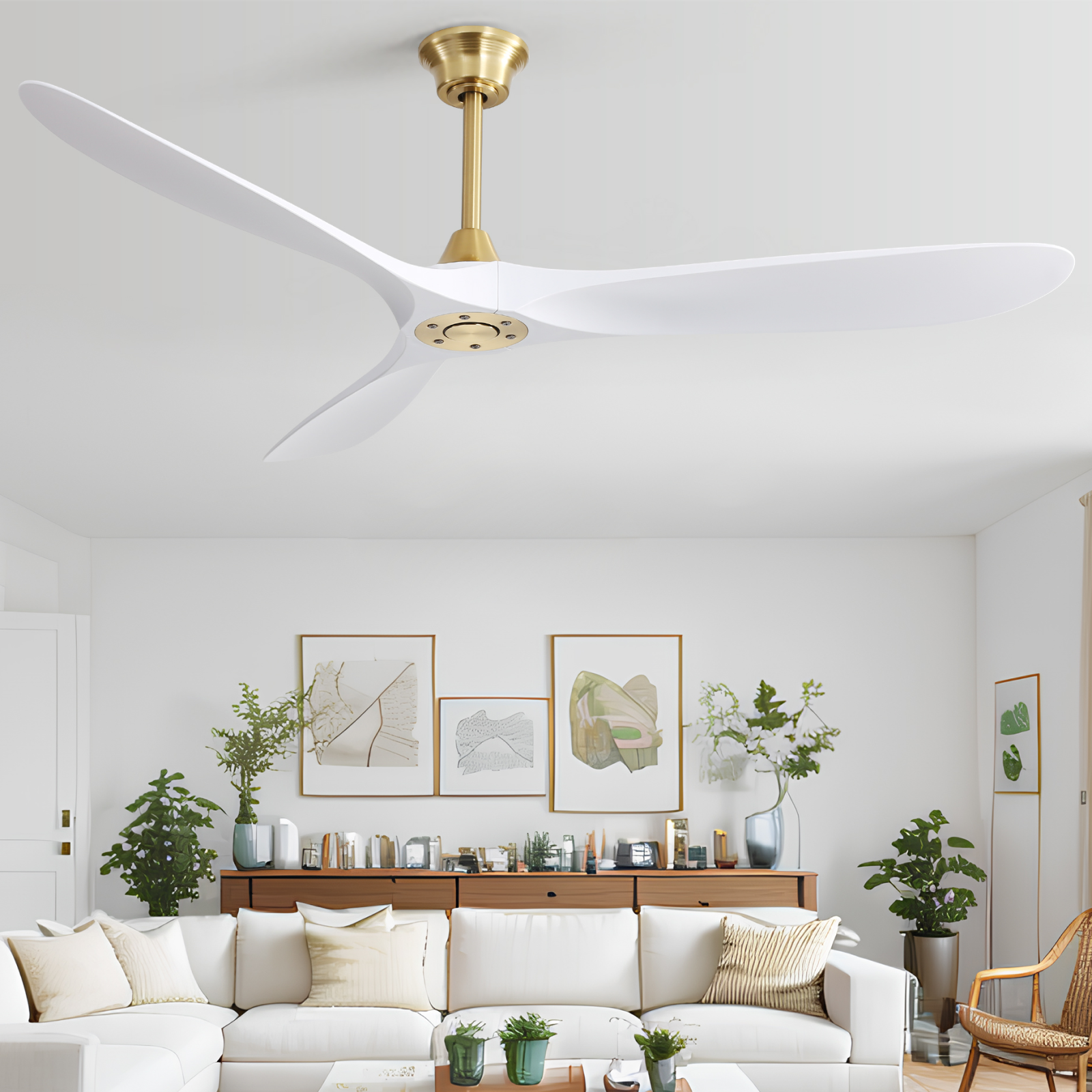
Airflow Capacity
When you pick a ceiling fan for a spacious room, airflow capacity becomes one of the most important things to consider. Airflow tells you how much air the fan can move, which directly affects cooling and comfort. If you want high cooling effectiveness, you need a fan that can deliver maximum airflow across the entire space. Larger fans, like the Rackora 60 Inch Modern ABS Ceiling Fan, have a bigger blade span. This means they push more air and create better airflow distribution, especially in open areas.
Let’s look at how different fan sizes compare:
|
Fan Size |
Model Name |
Blade Pitch (°) |
Airflow (CFM) |
Notes |
|---|---|---|---|---|
|
52 inch |
Striver |
15 |
5,070 |
Typical 52-inch airflow baseline |
|
52 inch |
Laurin |
15 |
5,070 |
Same airflow as Striver |
|
52 inch |
Araceli |
13 |
5,380 |
Slightly higher airflow |
|
52 inch |
Peridot |
15 |
5,580 |
Highest among 52-inch examples |
|
60 inch |
Icebreaker |
14 |
7,000 |
Significantly higher airflow |
|
60 inch |
Hunter Cassius |
N/A |
5,102 |
Lower airflow for 60-inch budget model |
|
60 inch |
Haiku L |
N/A |
7,638 |
About 30% more airflow than 52-inch fan |
You can see that 60 inch fans usually offer maximum airflow, with some models reaching over 7,600 CFM. This makes them a great choice for anyone who wants the best airflow and optimal performance in a large room.
CFM Ratings
CFM stands for cubic feet per minute. This rating shows how much air the fan moves every minute. If you want to match your fan to your cooling needs, you should always check the CFM rating. For rooms larger than 300 square feet, experts recommend a CFM between 4,000 and 6,000. If your room is over 450 square feet, you should look for a fan with a CFM between 5,000 and 9,000. This ensures you get the best cfm rating for your space.
- 300 to 450 sq ft: 4,000 to 6,000 CFM
- Over 450 sq ft: 5,000 to 9,000 CFM
A 60 inch ceiling fan often delivers maximum airflow and fits right into these recommendations. The Rackora 60 Inch Modern ABS Ceiling Fan, for example, provides strong airflow and optimal performance for large rooms. You can see from the chart below how 60 inch fans outperform 52 inch models in airflow:
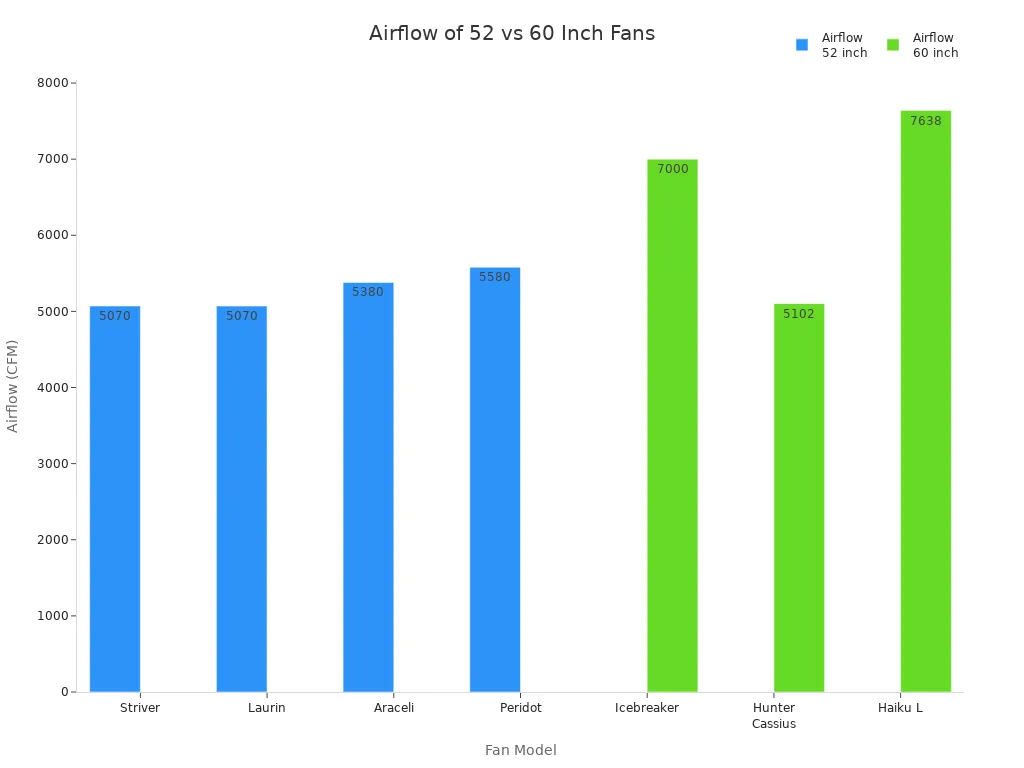
Large Room Circulation
If you have a big living room or an open concept space, you need a fan that can handle large room circulation. A 60 inch ceiling fan creates wider airflow patterns, which means you get even airflow distribution from wall to wall. This helps keep every corner of your room cool and comfortable. With higher CFM and maximum airflow, you can trust that your fan will meet your cooling needs, even during the hottest days.
Tip: For the best airflow and high cooling effectiveness, always match your fan’s CFM to your room size. This way, you get the most out of your fan’s performance and enjoy a comfortable home all year.
60 Inch Ceiling Fan Features
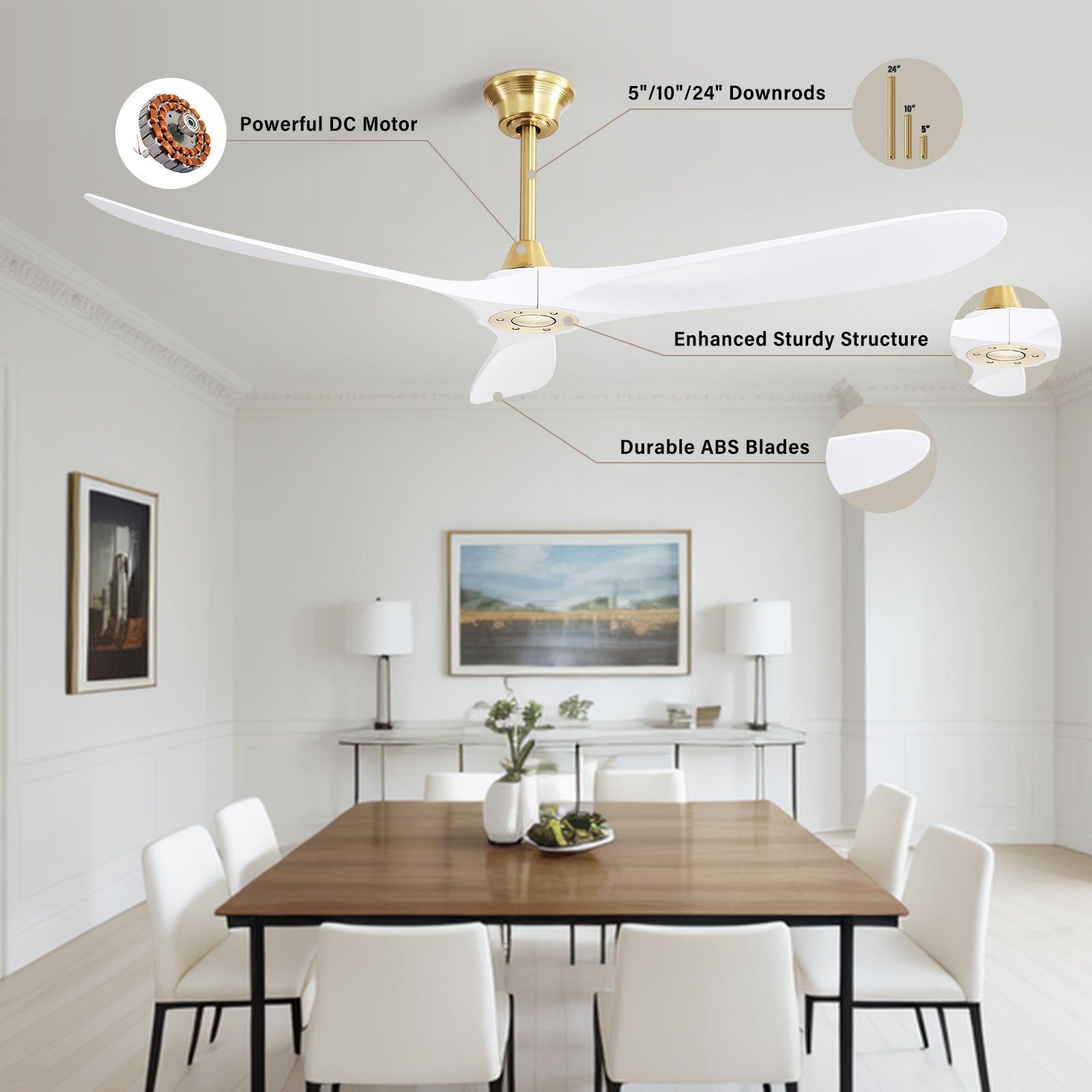
Modern Design
When you walk into a room, the first thing you notice is often the ceiling fan. The Rackora 60 Inch Modern ABS Ceiling Fan stands out with its sleek, modern look. The white ABS blades give your space a clean and fresh vibe. These blades are not just stylish—they are also tough and water-resistant. You can use this fan in many places, like living rooms, patios, or even a nursery. The gold accent adds a touch of luxury, making your room feel more elegant. You get a fan that matches almost any décor, from farmhouse to contemporary. The large 60 inch ceiling fan design means it covers more area, so you enjoy both style and comfort.
DC Motor Efficiency
You want a fan that works hard but does not waste energy. The Rackora fan uses a DC motor, which is a big step up from old AC motors. This motor runs quietly, so you can relax or watch TV without background noise. DC motors use less energy, which means you save money on your electric bill. In fact, this fan is about 65% more energy-efficient than many traditional fans. You get strong airflow without high energy costs. The fan’s efficiency also means it lasts longer and needs less maintenance. If you care about energy saving and want to lower your carbon footprint, this fan is a smart choice. You will notice the difference in both comfort and energy efficiency.
Tip: Choosing a fan with a DC motor is one of the best ways to boost energy efficiency and enjoy energy saving all year.
Smart Remote Control
Controlling your ceiling fan should be easy and convenient. The Rackora 60 Inch Modern ABS Ceiling Fan comes with a multifunctional remote. You can adjust the speed, turn the fan on or off, and change the direction of the blades—all from your couch. The remote has six speed settings, so you can pick the perfect airflow for any situation. It also comes with a wall holder, so you never lose track of it. While some 52 inch fans offer smart features like app control or voice commands, the Rackora remote focuses on simple, reliable control. You do not need to worry about complicated setups or Wi-Fi connections. Just use the remote for quick changes and enjoy the comfort. This makes it easy for anyone in your home to use the fan, no matter their tech skills.
If you want a fan that combines energy saving, efficiency, and easy control, the Rackora 60 Inch Modern ABS Ceiling Fan delivers on all fronts.
Reversible Function
Have you ever wondered why some ceiling fans have a “reverse” button? The reversible function is one of the most useful features you can get in a modern ceiling fan like the Rackora 60 Inch Modern ABS Ceiling Fan. This feature lets you change the direction the blades spin, which means you can use your fan all year—not just in the summer.
How does it work?
In the summer, you want the fan to spin counterclockwise. This pushes cool air down and creates a breeze that helps you feel cooler. You can set the Rackora fan to this mode with just a tap on the smart remote. The airflow moves straight down, so you get that refreshing wind-chill effect. You can relax, watch TV, or read a book without feeling stuffy.
When winter comes, you don’t have to turn off your fan. Instead, you can switch the direction to clockwise. This pulls cool air up and pushes the warm air near the ceiling back down into the room. Warm air rises, so without this feature, you might waste heat and money. The reversible function helps you save energy and stay comfortable, even when it’s cold outside.
Tip: Use the reversible function in the winter to help your heating system work less. You’ll notice your room feels warmer, and you might even lower your energy bills.
Here’s a quick guide to using the reversible function:
|
Season |
Blade Direction |
Effect |
Benefit |
|---|---|---|---|
|
Summer |
Counterclockwise |
Air moves down, cools room |
Feels cooler, less AC |
|
Winter |
Clockwise |
Air moves up, circulates heat |
Warmer room, saves heat |
You don’t need to climb up and flip a switch on the fan. The Rackora smart remote makes it easy. Just press the reverse button, and the fan changes direction instantly. This is perfect if you have high ceilings or hard-to-reach fans.
The reversible function also helps with air circulation in rooms that get stuffy or have uneven temperatures. If you have an open concept living area or a large bedroom, you’ll love how this feature keeps the air moving and the temperature balanced.
Why does this matter for you?
- You get comfort in every season.
- You save money on both cooling and heating.
- You make your home more energy-efficient.
- You enjoy easy control with the remote.
If you want a ceiling fan that works hard for you all year, the reversible function is a must-have. The Rackora 60 Inch Modern ABS Ceiling Fan gives you this feature, so you can stay comfortable no matter what the weather brings. Try it out, and you’ll see the difference in your home’s comfort and your energy bills.
Ceiling Fan Size Guide
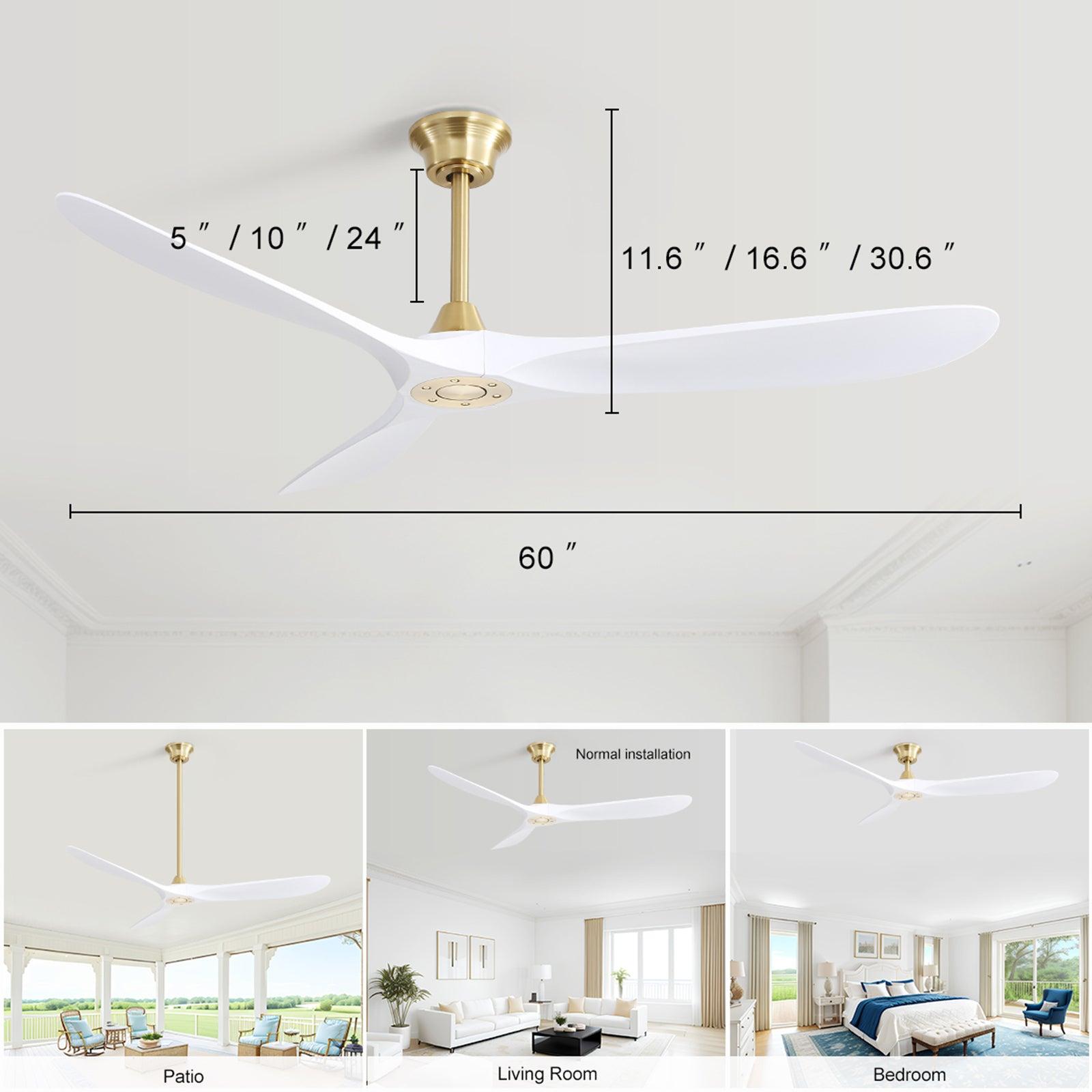
Room Size Recommendations
Choosing the right ceiling fan size for your room makes a huge difference in comfort and efficiency. You want a fan that fits your space, not one that is too small or too large. The industry standard says you should match the fan’s blade span to your room’s square footage. You measure a ceiling fan’s size by the distance from one blade tip to the opposite blade tip. For rooms with an even number of blades, measure straight across. For odd numbers, measure from the center to the tip and double it.
Here’s a quick guide to help you pick the right fan:
|
Room Size (Square Feet) |
Recommended Ceiling Fan Diameter |
Typical Room Applications |
|---|---|---|
|
Up to 75 sq ft |
29" – 36" |
Small bathrooms, laundry rooms, closets |
|
76 – 144 sq ft |
36" – 42" |
Bedrooms, home offices, kitchen nooks |
|
145 – 225 sq ft |
44" – 50" |
Master bedrooms, medium living rooms |
|
226 – 400 sq ft |
50" – 54" |
Large living rooms, great rooms, kitchens |
|
Over 400 sq ft |
56"+ |
Open floor plans, lofts, very large rooms |
If your room is between 12'x12' and 20'x20', you fall right into the range where a 60 inch ceiling fan works best. The Rackora 60 Inch Modern ABS Ceiling Fan fits these spaces perfectly, giving you the right balance of style and performance. You get strong airflow and efficient cooling, which means you stay comfortable all year.
Tip: Always check your room dimensions before buying a fan. A fan that is too small will not move enough air, while a fan that is too big can overwhelm the space.
Open Concept Spaces
Open concept spaces need special attention when it comes to ceiling fan size. These areas often combine living, dining, and kitchen zones into one large space. You want a fan that can handle the extra square footage and keep the air moving everywhere. A 60 inch ceiling fan, like the Rackora, stands out in these settings. It delivers powerful airflow that reaches every corner, making sure your cooling needs are met.
Smaller fans, such as 52 inch models, work well in medium rooms but may struggle in open layouts. You might notice uneven temperatures or dead spots where the air feels still. The Rackora’s large blade span and high CFM rating solve this problem. You get consistent airflow, even in rooms with high ceilings or lots of furniture.
If your open concept area is larger than 400 square feet, a single 60 inch fan often does the job. For extra-large or oddly shaped rooms, you might consider using two fans spaced apart. Make sure you install your fan at the right height—usually 8 to 9 feet from the floor—for the best results.
For open concept living, a 60 inch ceiling fan is your best bet for comfort and style.
Table: Room vs. Fan Size
Let’s make it even easier. Here’s a table that matches common room sizes to the recommended ceiling fan size. This will help you pick the perfect fan for your space:
|
Room Dimensions |
Approximate Area (sq ft) |
Recommended Fan Blade Span (inches) |
Best For |
|---|---|---|---|
|
12' x 12' |
144 |
52 to 60 |
Bedrooms, small living rooms |
|
16' x 16' |
256 |
52 to 60 |
Large bedrooms, family rooms |
|
20' x 20' |
400 |
60 to 72 |
Open concept, great rooms |
If you have a room that measures 12'x12', 16'x16', or 20'x20', you can see that a 60 inch ceiling fan is a smart choice. The Rackora 60 Inch Modern ABS Ceiling Fan covers these sizes with ease. You get the airflow you need for comfort, no matter how big your space is.
- For rooms up to 144 sq ft, a 52 inch fan works, but a 60 inch fan gives you more coverage.
- For rooms around 256 sq ft, both 52 and 60 inch fans fit, but the larger size ensures better air movement.
- For rooms up to 400 sq ft, always go with a 60 inch or even larger fan for the best results.
Remember: The right ceiling fan size keeps your room cool, saves energy, and looks great in your home.
Installation Tips
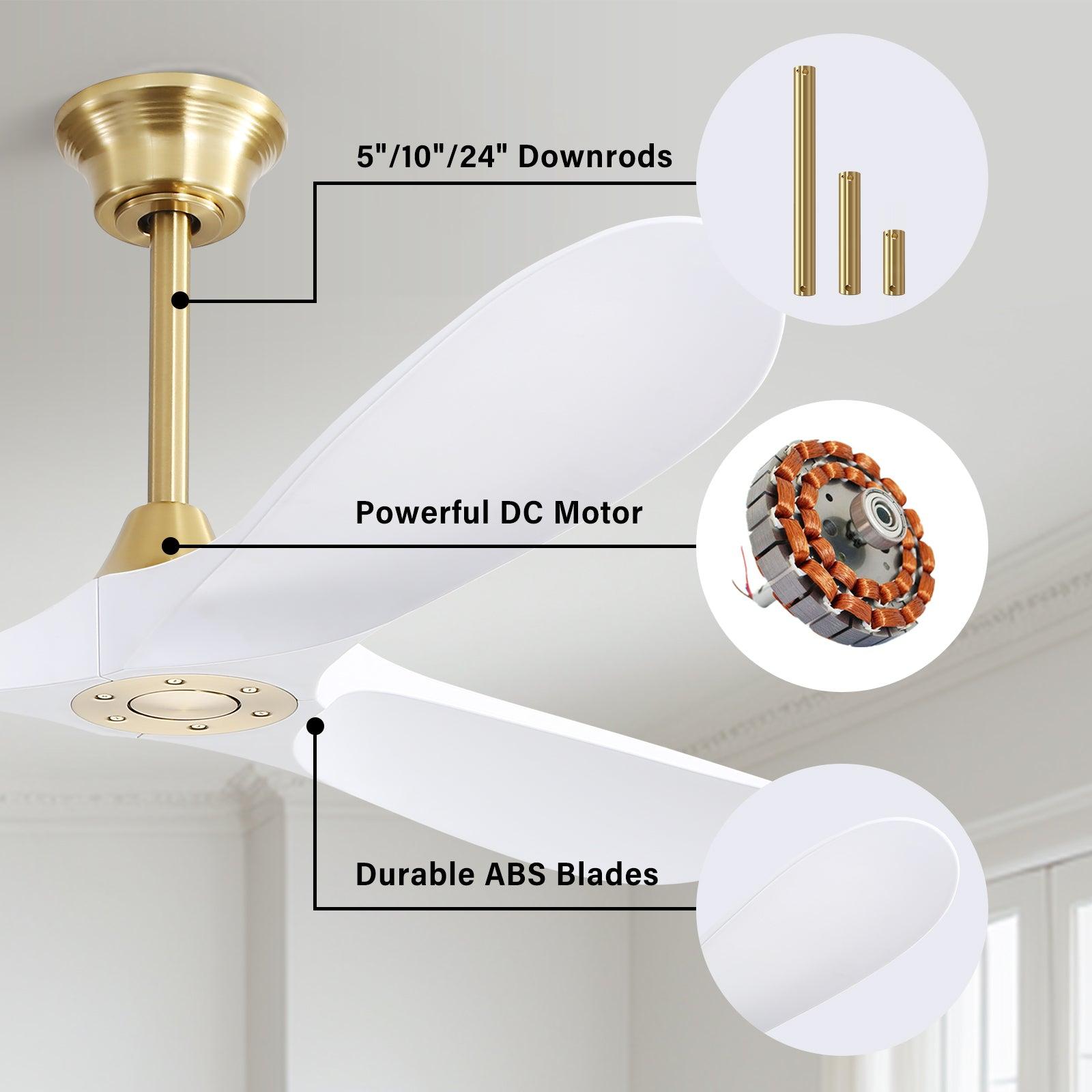
Ceiling Height
Before you start your ceiling fan installation, take a good look at your ceiling height. For both 60 inch and 52 inch fans, the sweet spot is a ceiling that’s at least 8 feet high. Standard mount fans work best when you have ceilings between 8 and 9 feet. If your ceiling is higher, you’ll want to use a longer downrod. This helps keep the fan blades about 8 feet above the floor, which is perfect for moving air efficiently in your room. You can figure out the right downrod length by subtracting 8 feet from your ceiling height, then adding about a foot for the motor and casing. If your ceiling is lower than 8 feet, consider a flush mount or hugger fan to keep things safe and comfortable. The size of your fan doesn’t really change the ideal height—it’s all about getting the blades in the right spot for the best airflow.
Tip: Always measure your ceiling height before starting installation. This simple step can save you a lot of hassle later.
Mounting Options
You have a few choices when it comes to mounting your ceiling fan, especially in a spacious room. Most large fans, including 60 inch models, mount directly to a fan-rated electrical box. This makes installation pretty straightforward for most homes. If you have a higher or vaulted ceiling, you’ll need a longer downrod to make sure the fan sits at the right height. This helps the fan move air across the whole room, not just in one spot. For really high ceilings, you might want to call in a professional to help with installation, especially if you’re dealing with a heavy or industrial-grade fan.
Here are some common mounting options:
- Standard mount to a fan-rated box (most common for residential installation)
- Longer downrod for high or vaulted ceilings
- Flush mount for low ceilings
- Professional installation for heavy or complex fans
Choosing the right mounting option ensures your fan works well and looks great in your space.
Support and Weight
Safety is key during installation, especially with a large ceiling fan. You want to make sure your ceiling can support the weight of the fan. Here’s a quick table to help you check what you need:
|
Aspect |
Details |
|---|---|
|
Fan Weight |
21 kg (45 lb) |
|
Minimum Support Strength |
Ceiling joists or structure must hold the fan weight |
|
Mounting Bracket Attachment |
Secure to ceiling joist or timber between joists with 4 wood screws |
|
Outlet Box Requirements |
Metal box supporting at least 35 lbs; avoid plastic boxes |
|
Additional Support |
Use a hanger bar or brace if no joist is present |
|
Blade Clearance |
Lowest blade point at least 7.5 ft from floor |
|
Clearance from Objects |
Blades at least 20 inches from walls or nearby objects |
|
Installation Notes |
Longer downrod may be needed for sloped ceilings |
Always use a metal outlet box rated for ceiling fans. If your room doesn’t have a ceiling joist where you want to install the fan, use a hanger bar or brace for extra support. Make sure the blades have enough clearance from the floor and walls. This keeps your installation safe and your fan running smoothly.
Note: Double-check all hardware and supports before finishing your installation. A secure fan means peace of mind for you and your family.
Features Comparison

Lighting Options
When you shop for a ceiling fan, lighting is often a big part of your decision. You want a fan that not only cools your room but also lights it up just right. Most 52-inch and 60-inch ceiling fans today come with LED lighting. You’ll find two main types: integrated LED lights and LED light kits. Integrated LEDs are built right into the fan, giving you a sleek look and energy savings. Light kits let you swap out or upgrade the light fixture if you want a different style later.
Here’s a quick look at popular models and their lighting options:
|
Fan Model & Size |
Lighting Option |
Brand |
|---|---|---|
|
Targas 52-Inch Espresso LED Fan |
Integrated LED |
Craftmade Lighting |
|
Dyno 52-Inch LED Fan |
Integrated LED |
Minka Aire |
|
Dempsey 52-Inch LED Fan |
Integrated LED |
Hunter Fan Company |
|
Aviation 60-Inch LED Fan |
Integrated LED |
Minka Aire |
|
Armstrong 60-Inch Ceiling Fan with Light Kit |
LED Light Kit |
Visual Comfort |
|
Streaming Smart 60-Inch LED Ceiling Fan |
Smart LED Light Kit |
Visual Comfort |
|
Lowden Smart 60-Inch LED Ceiling Fan |
LED Light Kit |
Visual Comfort |
You can see that LED lighting is the standard for both sizes. Some fans even offer smart LED kits, letting you control brightness and color with your phone or voice.
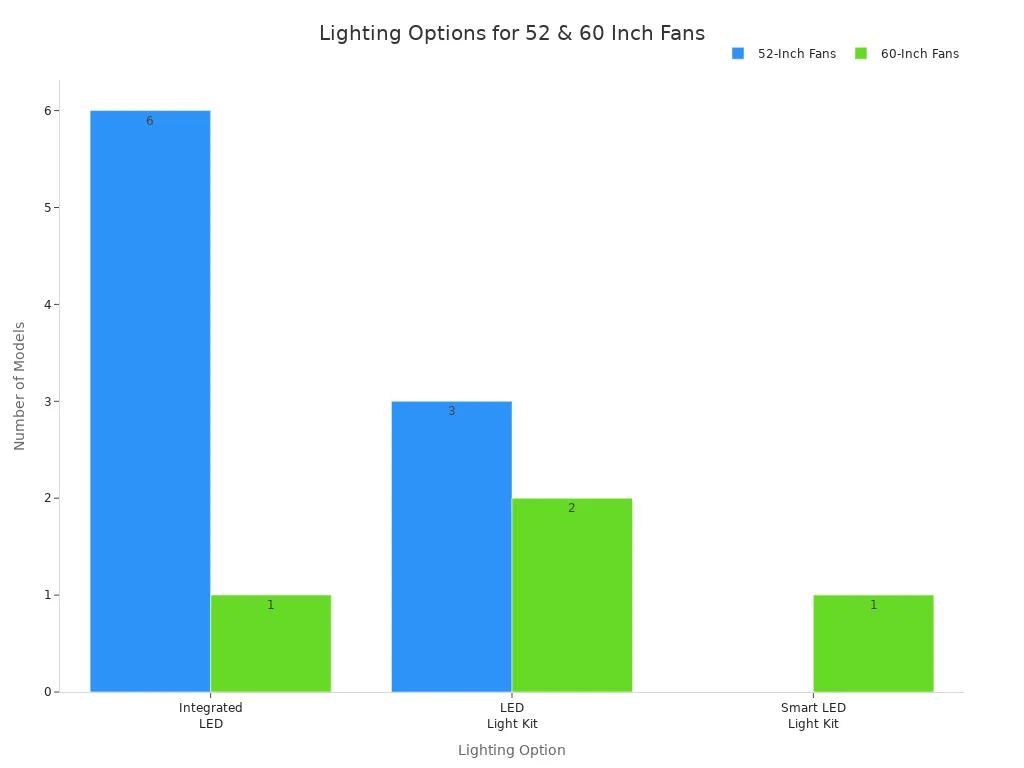
💡 Tip: If you want energy savings and long-lasting light, go for a fan with integrated LED lighting. It’s efficient and needs less maintenance.
Controls
You want your ceiling fan to be easy to use. Control options have come a long way, especially for larger fans. Both 52-inch and 60-inch models now offer a range of controls, from classic wall switches to advanced smart remotes and app integration.
Here’s how some popular fans compare:
|
Fan Model |
Size (inches) |
Control Type |
Speed Settings |
Smart Integration |
Convenience Features |
|---|---|---|---|---|---|
|
Hunter Phenomenon |
60 |
Six-speed wall control |
6 |
Wi-Fi, Alexa, Apple, Google |
Remote, voice, reverse, quiet |
|
Hunter Techne |
52 |
App & remote control |
4 |
Wi-Fi, Alexa, Apple, Google |
Voice, smart home, light dimming |
|
Minka-Aire Simple |
52 |
Six-speed remote |
6 |
Wi-Fi, Alexa, Google |
Light dimming, reversing, remote |
With the Rackora 60 Inch Modern ABS Ceiling Fan, you get a smart remote with six speeds and a reversible function. You can adjust airflow, change direction, and set your comfort level—all without leaving your seat. Some fans even let you use your voice or phone for total control.
🕹️ Note: If you love convenience, look for fans with smart controls. They make it easy to adjust settings from anywhere in the room.
Motor Types
The motor is the heart of your ceiling fan. It decides how quietly and efficiently your fan runs. Most modern fans use either AC or DC motors. DC motors are the new favorite for both 52-inch and 60-inch fans. They use less energy, run quieter, and offer more speed options.
The Rackora 60 Inch Modern ABS Ceiling Fan uses a DC motor. You get up to 65% more energy efficiency compared to traditional AC motors. DC motors also help your fan last longer and need less maintenance. If you want a fan that saves energy and keeps your room peaceful, a DC motor is the way to go.
⚡ Tip: Choose a fan with a DC motor for the best mix of power, quiet operation, and energy savings. You’ll notice the difference in your comfort and your electric bill.
Blade Materials
When you shop for a ceiling fan, you might focus on size and features first. But have you ever thought about what the blades are made of? Blade material plays a big role in how your fan looks, how long it lasts, and how well it works. Let’s break down the most common blade materials you’ll find in 60 inch and 52 inch ceiling fans.
Common Ceiling Fan Blade Materials
|
Material |
Pros |
Cons |
Best For |
|---|---|---|---|
|
ABS Plastic |
Lightweight, durable, water-resistant, easy to clean |
Less “natural” look than wood |
Indoors & outdoors, modern fans |
|
Wood |
Classic look, quiet operation, natural feel |
Can warp with moisture, needs care |
Bedrooms, living rooms |
|
Metal |
Strong, sleek, industrial style |
Can be noisy, not for damp areas |
Commercial, industrial spaces |
|
MDF/Composite |
Affordable, painted finishes, lightweight |
Not as durable, can swell with water |
Budget fans, dry indoor spaces |
You’ll see that each material has its own strengths. ABS plastic stands out for its durability and versatility. Wood gives you a warm, classic vibe. Metal blades look modern and work well in tough environments.
Why ABS Blades Are a Game Changer
The Rackora 60 Inch Modern ABS Ceiling Fan uses high-quality ABS (Acrylonitrile Butadiene Styrene) blades. You get several big advantages with ABS:
- Water Resistance: You can use your fan in humid rooms, patios, or even covered porches. No worries about warping or swelling.
- Lightweight: ABS blades put less strain on the motor. This means your fan runs quieter and lasts longer.
- Easy Maintenance: Just wipe the blades with a damp cloth. You don’t need special cleaners or treatments.
- Modern Look: ABS blades can be molded into sleek shapes and finished in any color. The Rackora’s white blades with gold accents look sharp in any décor.
💡 Tip: If you want a fan for both indoor and outdoor use, go with ABS blades. They handle moisture and temperature changes much better than wood or MDF.
Wood and Metal: When to Choose Them
Wood blades give your room a cozy, traditional feel. They work best in dry, indoor spaces like bedrooms or studies. If you love a rustic or farmhouse look, wood is a solid choice. Just remember, wood needs more care. Avoid using wood blades in bathrooms or kitchens where humidity can cause problems.
Metal blades shine in commercial or industrial settings. They move a lot of air and look bold. But metal can get noisy and isn’t great for damp areas. You’ll often see metal blades in warehouses or garages.
What Should You Pick?
Think about where you’ll use your fan. For most homes, ABS blades offer the best mix of style, strength, and low maintenance. If you want a fan that lasts and looks great, especially in large or open rooms, ABS is hard to beat.
🛠️ Note: Always check the blade material before you buy. The right choice keeps your fan running smoothly and your room looking its best.
Cost and Value
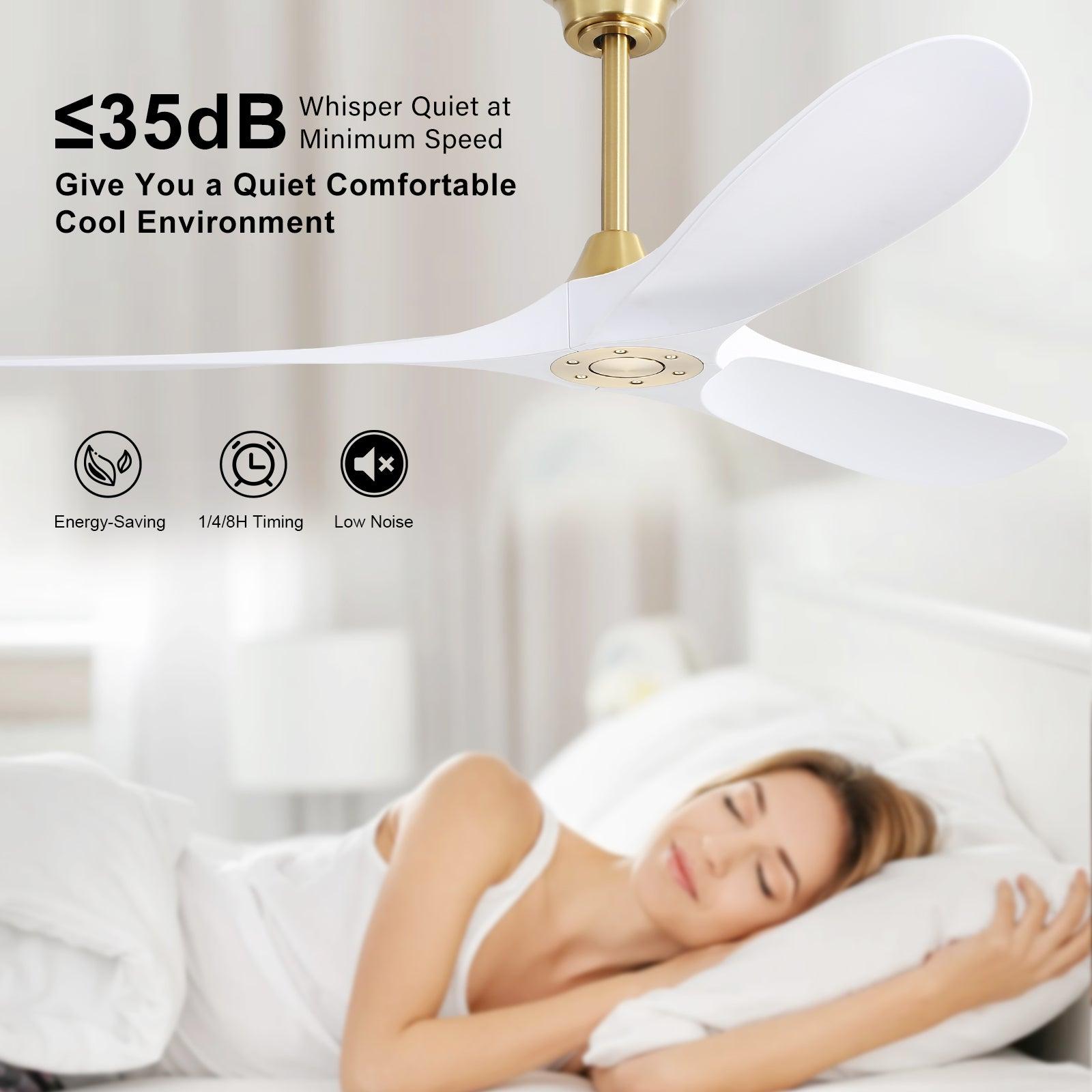
Installation Cost
When you pick out a ceiling fan for a large room, you might wonder how much it will cost to install. The size of your fan makes a big difference. Larger fans, like 60 inch models, usually need more time and effort to set up. This is because they are heavier and sometimes need extra wiring or support. Smaller fans, such as 52 inch models, are often easier and quicker to install.
Here’s a quick look at typical installation costs:
|
Fan Type |
Installation Cost Range (USD) |
Notes on Suitability and Complexity |
|---|---|---|
|
Standard |
$50 - $300 |
Typical fans, often 52-56 inches, suitable for rooms up to 350 sq ft. |
|
Rotational |
$350 - $1,850 |
More complex fans, often 60 inches or larger, ideal for large rooms and expansive spaces. |
You can see that installing a 60 inch fan can cost more than a 52 inch fan. The extra cost comes from the size, weight, and sometimes the need for special mounting or wiring. If your room is big and you want a fan that covers more space, you should plan for a higher installation bill. Always ask your installer for a quote before you start.
💡 Tip: If you have a high ceiling or a unique room shape, installation might take longer and cost more. It’s smart to check with a professional before you buy.
Operating Cost
After you install your fan, you’ll want to know how much it costs to run. Ceiling fans are known for being energy efficient, but the size and how often you use them can affect your electric bill. A 52 inch fan uses about 90 watts on average. If you run it for 8 to 12 hours a day, you’ll spend between $2.59 and $6.48 a month. Over a year, that adds up to about $25 to $65.
|
Fan Size |
Average Wattage |
Cost per Day (8-12 hrs) |
Cost per Month |
|---|---|---|---|
|
52-inch (Large) |
~90W |
$0.09 - $0.22 |
$2.59 - $6.48 |
For 60 inch fans, the exact numbers can change depending on the motor and features. Many modern 60 inch fans use energy-saving DC motors, which help keep costs low even though the fan is bigger. If you use your fan wisely and pick an energy-efficient model, you can keep your room comfortable without a big jump in your monthly bills.
🏡 Note: Using your ceiling fan with your air conditioner can help you save even more. You can set your thermostat a bit higher and still feel cool.
Value for Money
When you shop for a ceiling fan, you want to know if you’re getting real value for your money. It’s not just about the price tag. You want a fan that works hard, lasts long, and keeps your space comfortable without running up your energy bill. Let’s break down what makes a ceiling fan a smart investment for your home.
First, think about what you get for your money. A 60 inch ceiling fan, like the Rackora 60 Inch Modern ABS Ceiling Fan, offers more than just size. You get powerful airflow, energy savings, and features that make life easier. The DC motor uses less electricity, so you save money every month. The smart remote lets you control the fan from anywhere in the room. The reversible function means you can use the fan all year, not just in the summer.
Here’s a quick checklist to help you judge value for money:
- Airflow: Does the fan move enough air to keep you cool?
- Energy Efficiency: Will you save on your electric bill?
- Durability: Are the materials built to last?
- Features: Do you get extras like remote control or reversible blades?
- Warranty and Support: Is there a good return policy or guarantee?
You might pay a little more upfront for a larger, feature-rich fan. Over time, though, you’ll notice the savings. Energy-efficient fans cost less to run. Durable materials mean you won’t need to replace your fan as often. Smart features add convenience and comfort to your daily life.
Let’s compare the long-term value:
|
Feature |
60 Inch Fan (Rackora Example) |
52 Inch Fan (Typical) |
|---|---|---|
|
Airflow |
Maximum for large spaces |
Good for small rooms |
|
Energy Savings |
High (DC motor) |
Moderate |
|
Features |
Smart remote, reversible |
Basic controls |
|
Durability |
ABS blades, water-resistant |
Varies |
|
Year-Round Use |
Yes |
Sometimes |
💡 Tip: Don’t just look at the sticker price. Think about how much comfort, convenience, and savings you’ll get over the years.
If you want a ceiling fan that delivers strong performance, lasts for years, and helps you save money, a 60 inch model like the Rackora is a great choice. You’ll feel the difference every time you walk into your room.
Making Your Choice
Decision Checklist
Ready to pick the right ceiling fan for your space? Use this checklist to make sure you cover all the important points before you buy:
- Room Size and Square Footage: Measure your room. Fans between 52 and 60 inches work best for rooms larger than 144 square feet.
- Ceiling Height and Mounting Options: Check your ceiling height. For ceilings under 8 feet, go with a low-profile mount. Higher ceilings need a downrod to keep the fan at the right height.
- Airflow Requirements (CFM Ratings): Look at the fan’s airflow rating. Make sure it matches your room size for the best cooling and comfort.
- Room Layout and Purpose: Think about how you use the room. Place the fan where it can move air evenly. Bedrooms need quieter fans, while living rooms may need more power.
- Blade Count and Design: Choose a blade style that fits your taste and helps with airflow efficiency.
- Energy Efficiency: Pick a fan with a DC motor for quiet, energy-saving performance.
- Installation Requirements: Make sure your ceiling can support the fan’s weight and that you have the right electrical setup.
- Aesthetic Considerations: Match the fan’s style and color to your room’s decor.
- Outdoor Use Considerations: If you want a fan for outside, check for weather resistance and the right safety ratings.
- Budget: Factor in the cost of the fan, installation, and any extra features you want.
Tip: Take your time with this checklist. It helps you find a fan that fits your needs and gives you optimal performance.
Common Mistakes
Many people make the same mistakes when choosing a ceiling fan for a large room. Here’s a quick table to help you avoid them:
|
Common Mistake |
Explanation |
Recommendation |
|---|---|---|
|
Choosing incorrect fan size |
A fan that’s too small won’t cool the room; too large can overwhelm |
Match blade span to room size for the best airflow |
|
Neglecting ceiling height |
Wrong height affects safety and airflow |
Install fan at least 7 feet above the floor |
|
Ignoring fan placement |
Poor placement means uneven airflow and lighting |
Center the fan for even air and light distribution |
|
Overlooking clearance |
Not enough space can cause drafts and discomfort |
Leave enough space around the blades for safe and comfortable use |
Remember: The right size and placement make a big difference in your fan’s performance.
When to Choose Each Size
You might wonder when a 60 inch ceiling fan is the better choice over a 52 inch model. Here’s what you need to know:
- Pick a 60 inch fan if your room is large, open, or has high ceilings. These fans move more air and keep big spaces comfortable.
- Use a 52 inch fan for medium-sized rooms. Oversized fans in small rooms can create too much airflow, making the space feel drafty and uncomfortable.
- Large fans like the 60 inch models shine in great rooms, open concept living areas, or even commercial spaces. They deliver strong cooling and optimal performance where smaller fans just can’t keep up.
- If your room has a high or vaulted ceiling, you’ll need a longer downrod for a 60 inch fan. This keeps the blades at the right height for safe and effective airflow.
Note: Always match your fan size to your room. The right choice gives you the best cooling, comfort, and energy savings.
If you want the best comfort in a spacious room, a 60 inch ceiling fan usually works best. You should check your room size and use the guide to pick the right fit. Think about what matters most to you—performance, features, or style. Your room deserves a fan that matches your needs. Ready to upgrade? Take a look at options like the Rackora 60 Inch Modern ABS Ceiling Fan for your home.
FAQ
What size ceiling fan works best for a large living room?
You should pick a 60 inch ceiling fan for most large living rooms. This size moves more air and keeps the space comfortable. Always check your room’s square footage before you buy.
Can I use a 60 inch ceiling fan in a medium-sized room?
You can, but it might feel too powerful. For medium rooms, a 52 inch fan usually fits better. Measure your space and match the fan size for the best results.
How high should I hang my ceiling fan?
Keep the blades about 8 feet above the floor. If your ceiling is higher, use a longer downrod. This setup gives you the best airflow and safety.
Do I need a professional to install a large ceiling fan?
If you feel comfortable with tools and wiring, you can install it yourself. For high ceilings or heavy fans, hiring a professional makes the job safer and easier.
What is the benefit of a DC motor in a ceiling fan?
A DC motor uses less energy and runs quieter than an AC motor. You save money on your electric bill and enjoy a peaceful room.
Can I use a 60 inch ceiling fan outdoors?
Yes, if the fan has weather-resistant blades like ABS. Always check the manufacturer’s rating to make sure it’s safe for outdoor use.
How do I clean my ceiling fan blades?
Turn off the fan first. Use a soft cloth or a duster to wipe the blades. For tough spots, use a damp cloth. Clean your fan every few months to keep it running well.

